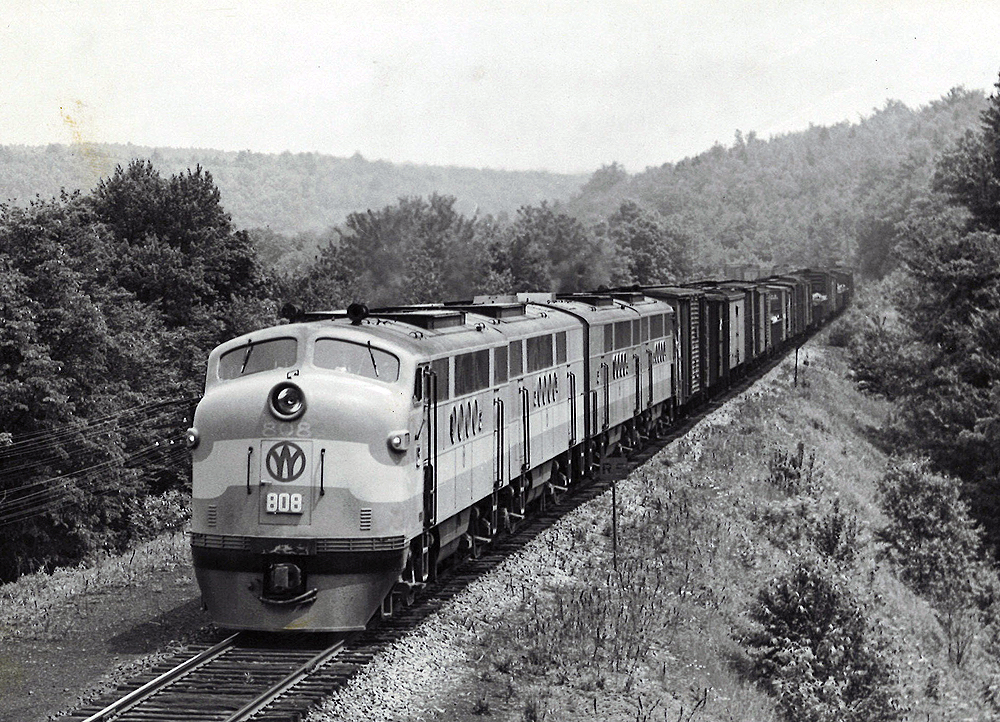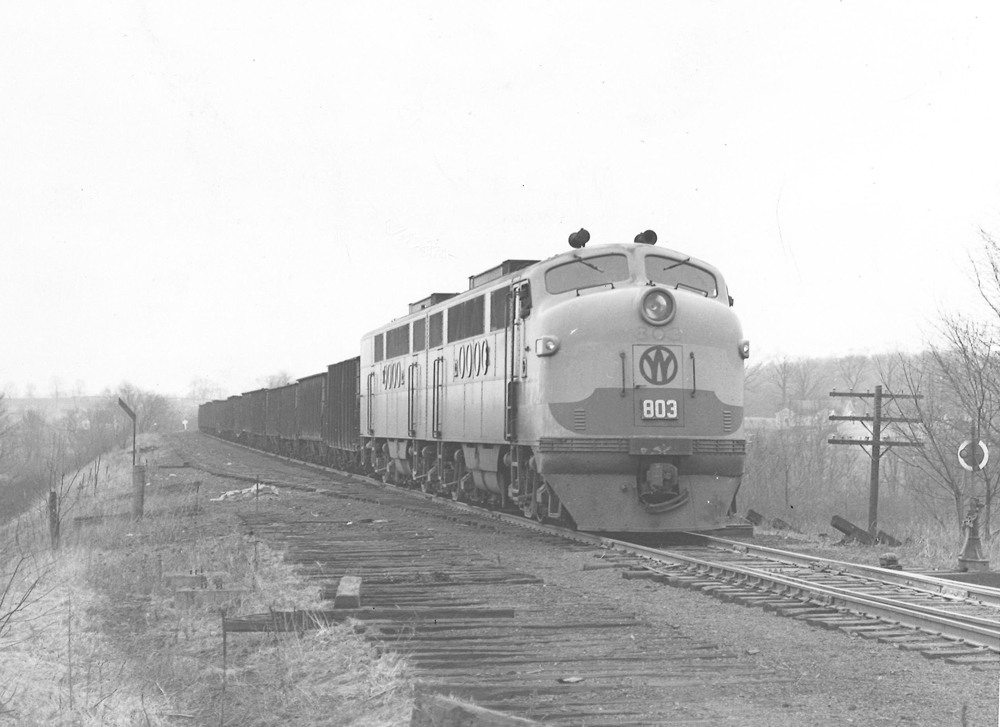
NickD
MegaDork
3/25/22 1:56 p.m.
The beast of the north east, one of Reading's mammoth class N-1sb 2-8-8-2 compound articulated locomotives. These Mallets were noted to be plenty powerful but ran out of breath quickly and were largely restricted to helper duty. The first eleven were used as donors to build some big Santa Fes, while the remaining 20 were converted to single-expansion N-1sd 2-8-8-0s by 1945. This photo was clearly taken at some sort of railfan excursion or event open to the public, because look at the women walking around the back of the tender, the guys in suits just behind the smokebox and the gentleman climbing into the cab: none of them are operating crew members.


NickD
MegaDork
3/25/22 4:02 p.m.
Reading built a batch of truly massive 2-10-2s, the heaviest in the US in fact, out of the N1 Mallets. It's not known how much exactly was used from the Mallets, I'm guessing largely just some of the boiler courses and the firebox (they both list 108 square feet of grate area). Listed as class K1-sa, they generated 90,000lbs of tractive effort, only 7,000 less than the N1-sa/N1-sb had made. There was also a single K1-sc, which had Caprotti poppet valves, but that was quickly converted back to a K1-sa after the Caprotti valve gear developed issues. And Baldwin delivered 10 2-10-2s that were identical in design but were completely new construction, which were classed as K1-sb. They became K1-sd when the third, driving axle was fitted with Baldwin cross-balanced Boxpok type drivers and tapered main rods in an attempt to fix hideous balancing issues at higher speeds.


NickD
MegaDork
3/25/22 4:08 p.m.
The K1s were involved in a pissing match between the Reading and the Western Maryland in the '30s. Western Maryland and Reading had trackage rights over each other, and the WM's big I-2 Decapods were notoriously hard on the track. WM in fact had a standing order that if an engineer had an I-2 that lost it's footing, he had to note the milepost and report it to MoW crews because the huge 2-10-0s would bend or break rails. Reading finally got sick of the WM's big Decapods chewing up their right of way and banned them from their rails. Western Maryland in turn banned Reading K1s from their rails, since they were just as punishing on infrastructure. It did not take long for the railroads to determine it was better to put up with each others locomotives than to lose the territory for their own, although I'm sure there was much cursing each other under their breath. Reading embarked on the K1-sd program to solve the imbalance issues with their Santa Fes, while WM slowly upgraded their I-2s with lightweight rods and valve gear and disc drivers as well.

NickD said:

I just love how odd & quirky these are.

NickD
MegaDork
3/25/22 7:27 p.m.
Pete Gossett (Forum Supporter) said:
NickD said:

I just love how odd & quirky these are.
I think that they have a certain visual appeal, particularly the Ten-Wheelers, like CNJ's T-38s.

As well as the NYO&W Class U 2-6-0, referred to as "the prince of Double Cabs" for their pleasing proportions and balance

In reply to NickD :
I also can't help but think that whoever penned the original concept did so after a liquid lunch.
In reply to NickD :
Is there a large dimensional difference in the cab being in the middle, compared to a similar axle count of a rear cab?

NickD
MegaDork
3/26/22 4:19 p.m.
In reply to DjGreggieP :
The actual reason for the Camelback/Mother Hubbard/Double Cab is a bit of a mystery. The story typically printed is that the wide Wootten firebox required for burning anthracite would have made for reduced forward visibility or a cramped cab, so they moved the engineer ahead of the firebox, while the fireman stood in the tender under an awning, called the kitchen, and pitched coal across.
Kelly Anderson, the now retired Chief Mechanical Officer at Strasburg said that this oft-told logic behind the design of the Camelback held no water with him. Visibility wasn't that much better, and railroad's weren't concerned at all about ergonomics or comfort on locomotives (look at the cab of a N&W M 4-8-0 or PRR E7s Atlantic). And the fact that there were Wootten firebox rear cab locomotives, like the big L&HR Consolidations or Reading T1s or D&H Pacifics, proves you could have an anthracite-burning rear cab locomotive. His theory was that when the Camelback was introduced, the power reverser had yet to be invented and you had a huge 4-foot tall Johnson bar sticking up out of the cab floor with a reach rod at the bottom that went all the way up to the valve gear. That reach rod had to be straight and strong and rigid and the Wootten firebox was smack dab in the road. By moving the cab up ahead of the firebox, you had a straight shot at the valve gear. It makes more sense to me than the usual explanation.
The end of Camelbacks is also a hotly debated subject. It's often said that the ICC flat-out banned Camelbacks in '35. That's not true, because CNJ has their T-38s on commuter runs until the end of steam in the '50s. CNJ #774 was literally the last steam locomotive on the property. Reading #1187 was operating at a steel mill until '62, and then ran another 5 years at Strasburg. The other story is that the ICC banned the construction of Camelbacks in '35 but allowed operation of existing locomotives to continue. That makes more sense. But several people say that after extensive research and poring through records archives, they have actually never found any evidence of the ICC taking any sort of actions against Camelbacks.
It seems instead that the Camelback just fell out of favor with railroads. Part of that was because the power reverser became commonplace, which instead had a shorter lever in the cab that controlled an air cylinder up on the valve gear and eliminated the reach rod. Reading, DL&W and D&H all converted a number of Camelbacks to rear cab locomotives. The other part was that as anthracite found uses in home heating, steel production and power generation, and then fell under the control of the War Resource Board in WWII, the Anthracite Roads lost their cheap fuel source. It just didn't make as much sense to build locomotives specifically to burn hard coal. Look at most of the later steam power, like the DL&W Poconos and Hudson's, or the Lehigh Valley Wyoming's, or the D&H's Northerns and Challengers, and they all have much more normal firebox sizes. Even the Reading T1s, despite having a huge Wootten firebox that sticks out past the cab, were designed to burn a mix of bituminous and anthracite coal and by the '40s, Reading was burning 100% soft coal.

NickD
MegaDork
3/28/22 11:23 a.m.
A Reading 2-8-0 Camelback and a G2-sa Pacific on the Catawissa Branch on October 29th, 1941 with the annual Catawissa Branch Rail Ramble. Hard to imagine that once upon a time, Class Is frequently ran their own railfan trips without any cajoling.


NickD
MegaDork
3/28/22 11:41 a.m.
Reading G3 Pacific #214 at VN Interlocking near Allentown, with the Harrisburg Special. The Reading G3s were the final Pacifics built in the US, constructed in the Reading's own shops in '48. That was a pretty late year to be building new steam locomotives, but the Reading was in a pinch for passenger power and the G2 and G2-sa Pacifics were over 20 years old, so they built ten of them. Mechanically impressive, with a 260psi boiler and 80" drivers, they were rather lacking in the aesthetics department. Like almost all steam locomotives constructed in the post-war era, they lived very brief lives, being displaced by diesels after a couple years. They spent their last years hauling commuters on the Pennsylvania-Reading Seashore Lines and then sat in the deadlines for a couple years waiting for the equipment trusts to run out before being scrapped. Don Wood tried, and failed to get one preserved, and though they were still extant when Reading dusted off the four T1s for the Irong Horse Rambles, sadly none of the G3s were revived for the program.


NickD
MegaDork
3/28/22 12:55 p.m.
Reading G1 Pacific #106 leaving Allentown.


NickD
MegaDork
3/28/22 1:27 p.m.
One of the Reading's clumsy-looking M1-sa Mikados ascends the grade at McCauley, PA on the Catawissa Branch, with two I9 Consolidations shoving on the rear.






NickD
MegaDork
3/28/22 2:17 p.m.
An M1-sa in helper service on the Catawissa Branch.


NickD
MegaDork
3/29/22 9:35 a.m.
Sixty five years ago today, on March 29, 1957, the New York, Ontario & Western Railroad ceased all operations after its final run between Oswego and Norwich. On that day, EMD FT No.805 departed Oswego, headed south through Fulton, skirting the north side of Oneida Lake, sounding one last blow of its whistle through villages and hamlets such as Central Square, Jewell, Constantia, North Bay, Sylvan Beach, Sylvan Junction, where it crossed over the Barge Canal, passing Fish Creek Station, through State Bridge where it crossed over Route 46 and the Erie Canal via Bridge no. 361 into Durhamville, beneath the NYS Thruway and not long after, the old New York Central mainline, and into the Oneida. At Oneida, the final train order was given to run NYO&W #116, an EMD NW2 switcher, extra to Norwich. At Oneida, the switcher was added to the fleet of cars in front of the caboose. As it left the Oneida yard, it passed beneath the West Shore overpass, across Route 5, through Kenwood, over the Kenwood trestle and continued on south through Munnsville, Hamilton, Earlville, until reaching its final destination at Norwich, putting an end to 89 years of service. The NYO&W, the last of the roads to reach the anthracite fields of PA, was the first to fall and a sign of things to come for the north east. It became one of the first Class Is in the US to be abandoned, and was abandoned almost in its entirety. The steam locomotives were all long gone, most of the freight cars were in too poor of condition to interchange anymore and were cut up, the EMD F3s and FTs were largely purchased by the New York Central and the Erie to be used as trade-in material, some of the 44-tonners and NW2s escaped the torch and still survived, and most of the rails, except for a few small snippets were torn up.


NickD
MegaDork
3/29/22 10:02 a.m.
NYO&W F3 #803 headed back to the mines at Burnside, NY with a train of empty hopper cars. You can see where the second track was removed as a cost-cutting measure in the face of declining profits.
























































